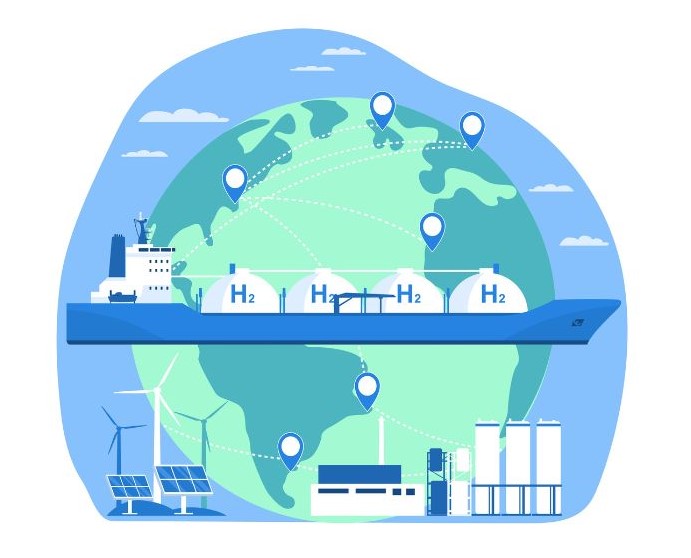
Hydrogen is the lightest, most abundant element on earth. It also serves as an energy carrier, and as such, holds great promise when it comes to decreasing the global reliance on fossil fuels. The problem, however, is that current methods of storing and transporting the molecule can be unsafe, inefficient, and expensive.
A multi-institution, multidisciplinary group of researchers led by Lehigh University recently received a $1.7 million grant from the National Science Foundation to fund the collaborative development of a new class of molecules, chemistries, and chemical processes to better store and transport green energy across the globe.
The team, which is led by Srinivas Rangarajan, an associate professor of chemical and biological engineering in Lehigh’s P.C. Rossin College of Engineering and Applied Science, includes investigators Dharik Mallapragada, New York University; Elizabeth Biddinger, City College of New York (CCNY); and Daniel Resasco and Steven Crossley, University of Oklahoma.
“This is a convergent effort where we’re looking at this problem in a multiscale manner,” says Rangarajan, “from the atomic scale all the way up to global supply chains.”
Variable energy sources, such as wind and solar farms, can generate more electricity than is needed at any given time. If a system were to pass that energy through water, the water would split into oxygen and hydrogen, with the resulting hydrogen molecules containing the renewably generated energy. Those molecules could then be stored and transported to where power is needed—like a manufacturing or chemical plant, a university or school, or a community of houses or apartments—and later burned to harness the reserved energy.
“Hydrogen is one of the lightest energy carriers, which is good because the amount of energy per gram of hydrogen is very high,” says Rangarajan. “But a gram of hydrogen also requires a lot of storage volume, unless you go to really low temperatures and really high pressure. So if you want to transport it over long distances, liquified hydrogen has to be stored at cryogenic temperatures at hundreds of pounds of atmospheric pressure.”
One technique currently in use to overcome this two-fold problem of transport and storage utilizes liquid organic hydrogen carriers, or LOHCs. Essentially, hydrogen is added to an organic molecule—called an hydrogen-lean molecule—that is liquid under ambient conditions to form another molecule which is also liquid, the hydrogen-rich carrier.
“At the point where hydrogen is being produced, you hydrogenate that hydrogen-lean molecule to store the hydrogen and form the hydrogen-rich molecule, which you ship to wherever it’s needed,” he says. “At the point of demand, you do what’s called dehydrogenation chemistry, which releases the hydrogen. The spent hydrogen-lean molecule is then shipped back to the point of supply of hydrogen where it can be reused.”
The LOHCs are very stable molecules, he says, and can be stored and transported using the same infrastructure used for hydrocarbons, including ships and trucks.
“There are demonstration projects going on around the world using this technology, and it could change the energy supply chain on a global level,” he says. “You can’t transport electricity from one continent to another, but you can transport energy through hydrogen.”
Rangarajan and his colleagues are devising a method that could improve how LOHCs are used in several ways.
They’re investigating a new class of alcohol-based molecules, a new class of chemistries, and associated chemical processes that could potentially increase the hydrogen storage capacity of the LOHC technology, and make the molecules safer to transport and handle. Their approach could also make the process more efficient by decreasing the energy penalty associated with the hydrogenation and dehydrogenation processes, steps in which some energy is normally lost.
Those steps also require catalysts—such as platinum or palladium—that can be expensive, he says.
“That’s where the novelty comes in,” he says. “We feel there are some intrinsic chemistries that can be driven by electricity instead of by heat, which could be helpful and much easier from a thermodynamic and kinetic perspective.”
To that end, the University of Oklahoma collaborators will study heterogeneous catalytic approaches to hydrogenate/dehydrogenate molecules. CCNY researchers will study analogous electrochemical approaches. NYU researchers will study the overall process economics, sustainability, and global impact of the choice of LOHCs and chemistries. Rangarajan will build models that connect molecular and chemistry information to process-level metrics.
The group will initially focus on a molecule they’ve already identified as promising. During the second half of the four-year project, they’ll employ artificial intelligence tools to screen for alternative hydrogen carriers with significant potential.
“There are 10 to the power of 60 small organic molecules that could potentially be synthesized,” says Rangarajan. “If you’re looking at large molecules, there are even more combinations. It’s actually a very difficult problem to solve, but there are some novel AI-based algorithms that can get you the right molecule and the right chemistries that you can then test with experiments.”
Identifying the correct combinations and chemistries at the atomic level could ultimately have significant repercussions on the global scale.
“We’re at a tipping point now with hydrogen,” says Rangarajan. “The U.S. is planning to spend $8 billion to incentivize building a dozen or so hydrogen hubs to produce hydrogen and use it to power transportation and industry. A breakthrough could open up new economies around the world and create a global supply of renewable energy.”

